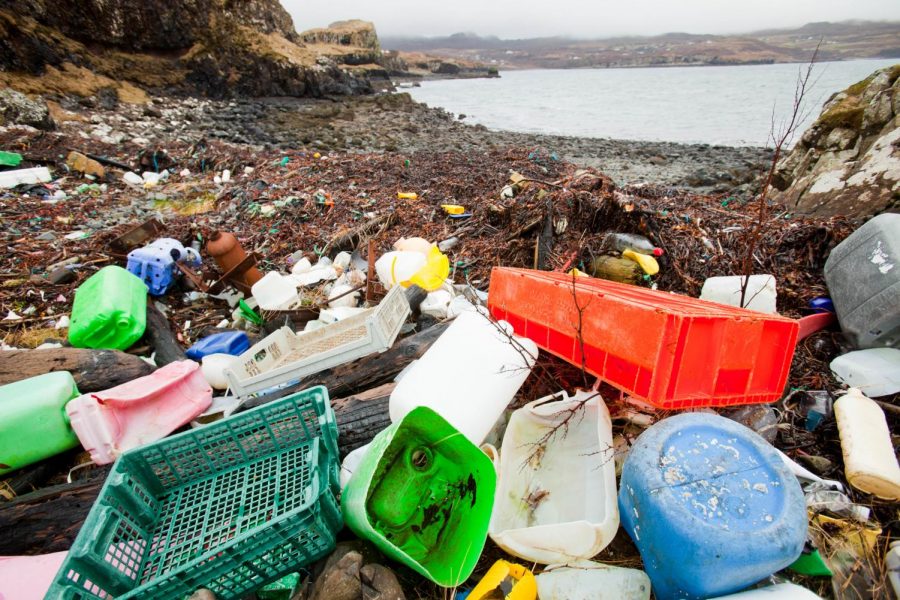How to Reduce your Carbon Footprint
October 15, 2019
Just three weeks ago, students walked out of school worldwide to protest global inaction on climate change. Swedish student Greta Thunberg delivered a passionate speech at the U.N. Climate Action Summit, stating that we are placing our own survival in extreme jeopardy for “money and fairy tales of eternal economic growth.” Even though society often looks to governments and world leaders to take the initiative in reducing carbon pollution, every person on the earth has a carbon footprint and therefore a responsibility to bear. The events of the past few weeks reminded me as a student of the ways I often prioritize convenience over sustainability and the environment.
The U.S. thrives in a culture of consumerism. A recent study estimated that every single American has a carbon footprint of at least 8.5 metric tons in carbon dioxide emissions, more than twice the global average of 4 metric tons per person. And in the wealthy suburbs, where students subside on plastic, energy, and water in overwhelming amounts, the need to shift the monologue of mass consumption can only be greater.
A Day in the Life of a Ludlowe Student
Your alarm clock rings as you rub your eyes sleepily. It’s only 6:30! Time to take a long hot shower. As you brush your teeth, the water sounds a melodic plink on the bottom of the sink. You rush out the door and head to Starbucks for a morning coffee. You thank the barista as she hands you a warm, delicious beverage in a plastic cup. On the way out, you grab a plastic stir stick and straw.
The morning bell rings as you head to your first period math class. You don’t understand anything that your teacher is saying so you sit back in your chair and pull out a stick of gum.
The bell sounds for the first lunch wave. You rush down to the cafeteria. As you open your bagged strawberries, you realize that you forgot a fork. Then you remember that you have an afternoon meet so you buy several water bottles from the vending machine.
It’s late when you finish your race for the day so you take home sushi in a plastic bag. Then you (grudgingly) start on your essay and lab report due the next day. When you finally wind down for the night, you leave your Chromebook on screen saver mode and plug in your phone.
How can this Ludlowe student become more energy conscious? Here are 10 suggestions for reducing your carbon footprint.
Take a 5 minute shower. Showers account for 17% of indoor water use, and standard showerheads use an estimated 2.5 gallons of water per minute. While the average shower in America lasts 8 minutes, taking shorter showers saves many precious resources: time, water, and energy!
Turn off the tap. Only 1% of water is available for human consumption. Over 1 billion people do not have access to safe drinking water, yet America uses 3.9 trillion gallons of water monthly. A simple action such as turning off the water while brushing teeth can conserve 200 gallons of water per month.
Say no to straws. Americans alone consume 500 million straws per day. These lightweight plastics can’t be recycled and escape as microplastics into the world’s oceans, representing a threat to the marine mammals that mistake them for food. Plastic particles now outnumber plankton in the ocean. Consider saying “no” to straws or buying metal or glass straws for personal use.
Avoid disposable coffee cups. 99.75% of coffee cups are not recycled; only four US cities have facilities that accept them. Paper cups are lined with polyethylene to keep them waterproof, which can break into microplastics and causes difficulty in the recycling process. Consider bringing a reusable coffee cup from home: many major coffee chains, including Starbucks, Panera, and Dunkin, offer reusable cup discounts.
Avoid plastic bottles. Plastic bottle manufacturing produces 2.5 million tons of carbon dioxide annually. A million plastic bottles are sold every minute, but 91% of them will not be recycled. Plastic bottles also contain the chemicals BPA and phthalates, both of which are endocrine-disruptive. Although grabbing water from the store or vending machine may seem more convenient than using a reusable bottle, drinking from bottled water actually costs the consumer $116 per month.
The environmental cost of gum. We all love chewing gum, but it comes in an abundance of packaging–and the gum base, the compound that makes a stick of gum satisfyingly chewable, often contains a plastic such as polyethylene or polyvinyl acetate. In comparison to other plastic items, it may seem insignificant, but some experts regard chewing gum as the second largest global litter source.
Avoid plastic bags. 500 billion plastic bags are used annually worldwide. Only 1 in 100 plastic bags end up in the recycling, and they can contaminate soil and ecosystems during the 300 years it takes for them to biodegrade in landfills. As with straws, marine animals can mistake plastic bags for food or become entangled in them; 100,000 die each year because of plastic pollution. Plastic production uses up 8% of the world’s oil. Consider washing and reusing zip-lock sandwich bags for lunch or use a reusable container. When shopping, bring a reusable bag. It will even save you 10 cents, because a state tax now applies to all single use checkout bags in Connecticut stores.
Avoid plastic cutlery. In 2050, there will be more plastic than fish in the world’s oceans. An estimated 40 billion individual plastic utensils are produced each year. Traditional plastic utensils are not biodegradable, compostable, or recyclable, though bio-plastic utensils are now available that satisfy these criteria. Consider bringing reusable or metal utensils from home. It only takes a small amount of effort to reduce your carbon footprint!
Turn off the Chromebook. Devices in idle power or screen-saver mode use up a quarter of residential energy. Consider shutting down the laptop or Chromebook each night instead of leaving them on to consume energy.
Don’t leave devices plugged in. Always leaving a laptop plugged in even when fully charged uses about 235 kilowatt-hours of energy per year, and doing the same nightly for the average phone uses about 6.5 kilowatt-hours of energy per year. This represents a very small portion of the average American’s annual energy consumption of 10, 972 kilowatt-hours in 2018; however, electricity production does account for 37 percent of America’s carbon dioxide emissions. For more drastic measures, consider asking your parents to switch from incandescent or compact fluorescent light bulbs to more efficient LED lights.
Every one of these sustainable changes are small but important. As Greta Thunberg eloquently said in her speech to the United Nations, “The world is waking up. And change is coming, whether you like it or not.” The current class of FLHS students come from the generation who will be impacted by climate change, by rising sea levels, extreme weather events, unprecedented temperatures, ocean acidification, a challenged food supply, pollution, collapsing ecosystems, and massive loss of biodiversity. Will you and I be part of the problem, or part of the solution?


